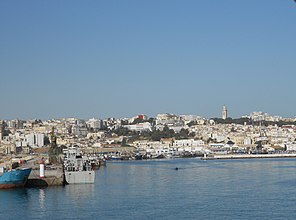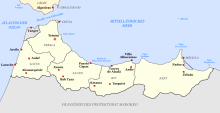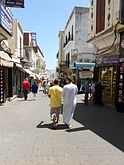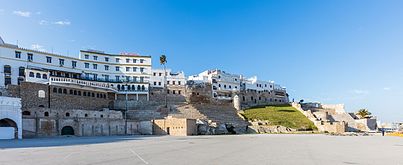Tangier
| Tangier طنجة ⵜⵉⵏ ⵉⴳⴳⵉ |
||||
|---|---|---|---|---|
|
||||
| Basic data | ||||
| State : |
|
|||
| Region : | Tangier-Tétouan-Al Hoceïma | |||
| Prefecture : | Tangier Asilah | |||
| Coordinates | 35 ° 47 ′ N , 5 ° 49 ′ W | |||
| Residents : | 974,952 (2014) | |||
| Area : | 250 km² | |||
| Population density : | 3,900 inhabitants per km² | |||
| Height : | 80 m | |||
| City administration website : | ||||
| Tangier | ||||
Tangier ( Arabic طنجة Tandscha , DMG Ṭanǧa , Zentralatlas-Tamazight ⵜⵉⵏ ⵉⴳⴳⵉ Tin Iggi , Spanish Tánger ) is a city with about one million inhabitants in northwest Morocco in the province of Tangier-Asilah . It is located on the North African coast west of the Strait of Gibraltar .
location
The city of Tangier is located near the north-western tip of Morocco; it extends between several hills near the coast at heights of approx. 10 to 130 m . The climate is influenced by both the Mediterranean and the Atlantic and can be mild as well as cold and stormy; the rain, which is abundant for Moroccan conditions (approx. 760 mm / year), falls predominantly in the winter months.
To the south of the city is Tangier-Boukhalef Airport ; Since 2007, Tanger-Med has been a seaport between Tangier and Ceuta for container and RoRo handling on the Mediterranean . The city is connected to the LGV Tangier – Kenitra high-speed railway .
population
| year | 1994 | 2004 | 2014 |
| Residents | 497.147 | 687,667 | 947,952 |
The city's population consists almost exclusively of members of various Berber tribes from the area. Most of them have immigrated since the 1970s - because of the harsh working conditions in their home villages, but also for socio-cultural reasons (hope for work, improvement of material living conditions and health care, better opportunities for schooling for their children, etc.).
economy
Tangier is first and foremost a port and trading city, but many craft businesses and service providers of all kinds have also settled here. For example, North Sea crabs are picked in huge halls in the vicinity of the city . The automobile group Renault has been producing vehicles of the group brand Dacia in Melloussa near Tangier since 2012 . Later on, up to 400,000 vehicles are to be produced, from 2016 also a vehicle that should not cost more than the equivalent of 3,000 euros in markets like India .
These vehicles are also shipped from Tanger's seaport, Tanger-Med . In 2015, a total of 42.0 million tons of goods were handled there (an increase of + 0.9% compared to 2014), including 2.96 TEU (−3.7%), 5.3 million tons of liquid goods (crude oil) ( + 38%), 496,400 t of general cargo (+ 17%), 237,000 trucks / trailers (+ 8%) were handled in Ro-Ro traffic, new vehicle handling for Renault was 260,000 vehicles (+ 23%), and 63,000 vehicles (+ 48%) shipped.
In addition, Tangier is of great tourist importance. These are usually day-trippers from vacation in Andalusia . Tangier is only an hour away by boat from Tarifa, Spain .
history
According to legend, Antaios , son of Poseidon and Gaia , founded the city. Hercules split the earth at this point, creating the Strait of Gibraltar , in which the Mediterranean and the Atlantic mix their waters.
Tangier was probably founded in the 5th or 6th century BC. Founded by Carthaginians . The settlement of Tingis later came under Roman ( see also: Mauretania Tingitana ) or Byzantine rule before it was conquered by the Arabs in 702 .
The Portuguese arrived in 1471, followed by the Spanish in 1580 and the British in 1661 - Catherine of Braganza brought it as a dowry for her marriage to Charles II . But shortly afterwards (1684) Tangier was handed over to Morocco under the Alawids .
The geographical location of Tangier made the city the Moroccan center of European diplomacy and economy in the late 19th and early 20th centuries. The speech of Kaiser Wilhelm II on the occasion of his visit to the city (1905), in which he made a declaration on the continued independence of Morocco, triggered an international crisis .
In 1912, however, Morocco lost its independence and was in fact divided between France and Spain , with the latter occupying all of northern Morocco and part of the Atlantic coast in the south. The status of Tangier remained unclear. In 1923 the city and a small area around it was declared the International Zone of Tangier and administered by eight powers (France, Spain, Great Britain, the Netherlands, Belgium, Portugal, the Soviet Union and, since 1928, Italy). The port of Tangier was duty free and smuggling became a profitable business.
Tangier had around 60,000 inhabitants in 1927, including 35,000 Muslims, 15,000 Jews and 10,000 foreigners. In 1950 there were around 150,000 people living in the city, including 43,000 Christians and 15,000 Jews. In this way, a unique multi-ethnic community of Christian nationalities and the (Jewish and Muslim) subjects of the Sultan established itself during the time of the Zone. At that time Tangier could be described as the most modern city in Africa with its infrastructure; however, it was never a European colony.
This state remained, with the exception of the period from 1940 to 1945, when it was under sole Spanish administration due to the Second World War , until October 29, 1956 (however, Italy was replaced by the USA and the USSR ). The free movement of the city in the 1940s and 1950s made it a magnet for European and American writers, for "dropouts" and outsiders of all kinds. On October 29, 1956, however, the " Protocols of Tangier " came into force, which the city was involved in reunified the state of Morocco, which had regained its independence a few months earlier, and ended their freedom of movement. After that, the exodus of around 13,000 Jews, or Hebrews, as they called themselves, from Tangier began. Since about 2015 the city has had a population of over a million, about 5,000 foreigners are officially registered by the various consulates, and there are said to be only 70 local Jews.
In the 1960s and 1970s Tangier experienced a political and economic decline, but a second literary heyday as a “Mecca” for European and US writers of the newly emerging pop literature . Paul Bowles , Jane Bowles , Tennessee Williams , Jack Kerouac , Muhammad Asad , Truman Capote, and William S. Burroughs were just a few of them. Except for the Bowles couple, the writers are not permanent residents of the city, but expatriate visitors. These were literarily very productive, their representations dominate Tanger's image for Americans and Europeans to this day. Morocco's most famous writer, Mohamed Choukri , also lived here. He processed his experiences as a poor adolescent in Tangier in the 1950s in his novel “Das nackte Brot” (“al-Chubs al-hafi” in Arabic). The multibillionaire Malcolm Forbes , actress Elizabeth Taylor and Woolworth heiress Barbara Hutton later lived in the city. The former Israeli Foreign Minister Schlomo Ben Ami , the Spanish Almodóvar actress Bibiana Fernández and the French socialist leader Jean-Luc Mélenchon were also born in Tangier. Well-known authors still live in the city today (e.g. Bernard-Henri Lévy ).
Under the reign of Hassan II , the city and northern Morocco were neglected as planned. It was not until the reign of King Mohammed VI. (from 1999) Tangier experienced a new bloom. Large-scale urban projects such as the uncovering of the old city walls or the relocation of the port functions to the new seaport Tanger-Med east of the city, as well as the urban renovation program Tanger-Métropole, have been fundamentally redesigning Tanger's character since around 2010.
Attractions
The stone box tombs of the Marshan necropolis , which were carved into the rock and reused in Roman times, date from Carthaginian times . In the 3rd and 4th centuries, the Romans surrounded the castle hill - today's Kasbah district - with a city wall that was reinforced by the Portuguese in the 15th and 16th centuries. The Kasbah Museum is well worth seeing with many interesting archaeological finds from the city's more than 2000 years of history; The highlight is the floor mosaic from Volubilis depicting a "sea voyage of Venus". The city's greatest attraction is the lively medina (old town) around the Petit Socco with its markets, craft shops, shops and cafes. There are several galleries in the vicinity of the Grand Socco ; they present changing exhibitions with works by Moroccan and European artists. The Anglican Church of St. Andrew , built in 1894, with the cemetery surrounding it is also worth a visit.
- Surroundings
Not far from Cape Spartel is the Hercules grotto , in the vicinity of which are the ruins of the Roman Garum factory in Cotta .
Culture
The Mediterranean character that distinguishes Tangier from other cities in Morocco is significant. In general, the city was shaped by the coexistence of European, Muslim and Jewish cultures. For example, the old town is architecturally shaped to a large extent by typical Mediterranean architectural features (e.g. windows facing the street, balconies). The influence of Romance languages is also reflected in the local Arabic dialect (e.g. forn from Spanish horno for oven, cusina from Spanish cocina for kitchen). The religious groups lived together in the same neighborhoods and apartment blocks, in the time of the International Zone the class stratification was more important than that of national origin or classification. In addition to their official religious orientations, members of all groups also cultivated the worship of the jinn , who had special venues for worship in Tangier: in particular the rocks of Lalla Jmila and Sidi Hammou were worshiped by Christian, Jewish and Muslim women in order to ask for happiness and fertility. The sanctuary of Sidi Maimoun is still visited today for these reasons. Traditionally, the guilds and the Sufi fraternities of the Gnawa , Aissawa and Hamadsa have played an important role in the cultural fabric of the city.
With the influx of Moroccans from the hinterland, especially since the 2000s, the cultural character of the city has changed significantly. Today in Tangier you can find more and more veiled women; Until the 2000s, the city was characterized by a casual style of clothing - especially by women (European skirts, open hairstyle). This change is the most visible sign of the general development of local culture since the turn of the millennium, away from a Mediterranean to an increasingly Arab lifestyle. The Tanjazz Jazz Festival has been held every summer since 2000 .
sons and daughters of the town
- Hassan Akesbi (* 1934), Moroccan national soccer player
- Ibn Battūta (1304–1377), Berber explorer of the 14th century
- Schlomo Ben-Ami (* 1943), Israeli diplomat, historian and politician
- Karim Debbagh (* 1972), Moroccan film producer
- Bibiana Fernández (Bibi Andersen) (* 1954) Spanish actress
- Henri Gillet (* 1953), mathematician
- Hicham Hamdouchi (* 1972), Moroccan chess player
- José Hernández (1944–2013), Spanish painter and visual artist
- Jean-Marie Machado (* 1961), French jazz pianist and composer
- Jean-Luc Mélenchon (* 1951), French politician
- Eduardo Niebla (* 1955), Spanish guitarist, arranger and composer
- Hagen Schulze (1943–2014), German historian
- Heinz Tietjen (1881–1967), German composer and director of the Bayreuth Festival
- Antonio Ángel Vázquez Molina (1929–1980), Spanish writer
- Jorge Verstrynge (* 1948), General Secretary of the Spanish party Alianza Popular between 1979 and 1986
People connected to the city
- George Apperley (1884–1960), British painter
- Jane Bowles (1917–1973) American writer
- Paul Bowles (1910-1999), American writer
- William S. Burroughs (1914–1997), American writer of the Beat Generation
- Truman Capote (1924–1984) American writer
- Elisa Chimenti (1883 in Naples , died 1969 in Tangier), Italian journalist, educator, writer and ethnologist
- Marthe de Chambrun-Ruspoli (Princess) and lover of Jane Bowles `
- Eugène Delacroix (1798–1863), French painter
- Tamara Dragadze (* 1943) British-Georgian princess, ethnologist and political activist
- Malcolm Forbes (1919–1990) American magnate
- Antonio Fuentes , Spanish painter
- Giuseppe Garibaldi , exiled in Tangier from October 1849-June 1850
- Dieter Haller (* 1962), German ethnologist (field research in Tangier 2013–2014, and to this day)
- Barbara Hutton (1912–1979) American heiress
- Boris Kerenski (* 1971), German journalist (editor, together with Florian Vetsch of the "Tanger Telegram. A journey through the literatures of a legendary Moroccan city" 2004/17)
- Jack Kerouac (1922–1969), American writer of the Beat Generation
- Henri Matisse (lived in Tangier 1912/1913)
- Ignacio Ramonet (* 1943), founder of Attac , lived in Tangier in his youth
- Adolf Renschhausen German councilor and entrepreneur, lived in Tangier from 1890 to 1914
- Elizabeth Taylor (1932-2011) British actress
- Edvard Westermarck (1862–1939), Finnish ethnologist
- Tennessee Williams (1911-1983), American writer (wrote The Cat on a Hot Tin Roof in Tangier)
Climate table
| Tangier | ||||||||||||||||||||||||||||||||||||||||||||||||
|---|---|---|---|---|---|---|---|---|---|---|---|---|---|---|---|---|---|---|---|---|---|---|---|---|---|---|---|---|---|---|---|---|---|---|---|---|---|---|---|---|---|---|---|---|---|---|---|---|
| Climate diagram | ||||||||||||||||||||||||||||||||||||||||||||||||
| ||||||||||||||||||||||||||||||||||||||||||||||||
|
Average monthly temperatures and rainfall for Tangier
Source: wetterkontor.de
|
|||||||||||||||||||||||||||||||||||||||||||||||||||||||||||||||||||||||||||||||||||||||||||||||||||||||||||||||||||||||||||||||||||||||||||||||||||||||||||||||||||||||||||||||||||||||||||||||||||
literature
- Arnold Betten: Morocco. Antiquity, Berber Traditions and Islam - History, Art and Culture in the Maghreb. DuMont, Ostfildern 2012, p. 129f, ISBN 978-3-7701-3935-4
- Martin Malcolm Elbl: Portuguese Tangier (1471–1662): Colonial Urban Fabric as Cross-Cultural Skeleton. Baywolf Press, Toronto and Peterborough. ISBN 978-0-921437-50-5
- Dieter Haller: Tangier - the port, the ghosts, the lust. Transcript, Bielefeld 2016. ISBN 978-3-8376-3338-2
- Florian Vetsch , Boris Kerenski : Tangier Telegram. Journey through the literatures of a legendary Moroccan city . bilgerverlag, Zurich 2017. ISBN 978-3-03762-061-8
- Tangier Pocket City-Guide is a free monthly magazine that presents addresses and cultural events in the northern region of Morocco on paper or online at tangerpocket.com or via the Android app Tanger Pocket
Web links
Individual evidence
- ↑ Tangier - Population Statistics
- ↑ Tangier - map with altitude information
- ↑ Tangier - climate tables
- ↑ Michael Kläsgen: Renault relies on super cheap. sueddeutsche.de of February 10, 2012 , accessed on February 11, 2012
- ↑ Port of Tanger Med: Less TEU in 2015 . In: Daily port report of January 27, 2016, p. 13
- ↑ FRS "Tanger Basic"
- ^ Enid MG Routh - Tangier: England's Lost Atlantic Outpost, 1912; Martin Malcolm Elbl, “(Re) claiming Walls: The Fortified Médina of Tangier under Portuguese Rule (1471–1661) and as a Modern Heritage Artefact”, Portuguese Studies Review 15 (1–2) (2007; publ. 2009): 103 -192; Martin Malcolm Elbl, “Tangier's Qasba Before the Trace Italienne Citadel of 1558–1566: The 'Virtual' Archeology of a Vanished Islamic and Portuguese Fortress,” Portuguese Studies Review 17 (2) (2009; publ. 2012): 1-44. on-line
- ^ Neue Zürcher Zeitung : Protected, suppressed, tolerated - Jewish life in Islamic countries - a tradition at risk February 25, 2008
- ↑ Tangier - antique Garum factory from Cotta
- ↑ Tanjazz
















